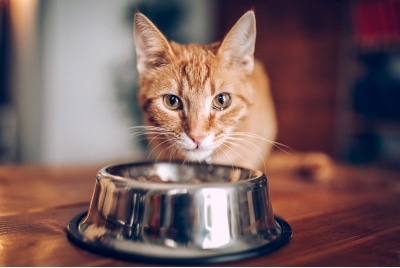

Chronic kidney disease (CKD) is one of the most common disorders of cats and a common cause of mortality in older cats. Veterinarians don’t know what causes chronic kidney disease, but we know feeding a special diet helps cats with CKD maintain quality of life. In cats with CKD, kidney diets have been shown to be superior to regular adult cat food in limiting episodes of illness and death related to chronic kidney disease. Today’s blogpost will focus on the benefits of feeding your cat a kidney diet when they have a CKD diagnosis.
How does CKD affect feline kidney function?
Kidneys control water balance in the body, excrete byproducts of protein digestion and control potassium and phosphorous levels through retention or excretion of these minerals in the urine. In chronic kidney disease, the kidneys fail to perform their normal functions. Cats with CKD easily become dehydrated. Blood tests will show increased phosphorus and decreased potassium. Blood urea nitrogen (BUN) and creatinine rise, indicating the kidneys can no longer manage these byproducts of protein digestion. Veterinarians use a scoring system called IRIS (International Renal Interest Society) Stage. The system ranks the severity of kidney disease on a scale of 1-4, with 1 being minor and 4 being very serious. The IRIS treatment guidelines suggest starting a kidney diet when a cat reaches IRIS Stage 2.
What makes a kidney diet different from a regular cat diet?
Kidney diets are designed to minimize the impact of CKD on cats. These specially formulated diets have more potassium and less phosphorus than a normal diet to compensate for the reduced kidney function. The diets also contain highly digestible protein in reduced amounts to decrease the demands of protein digestion byproduct excretion. Inflammation can be an issue in cats with CKD, so many kidney diets contain anti-inflammatory omega-3 fatty acids.
How should I start my cat on a kidney diet?
In general, cats are not fans of change—but if the kidney diet is going to help, they need to eat it. Don’t hesitate to try different brands of kidney food and introduce the new food slowly. Use a separate plate for the kidney diet and only serve a small portion until your cat is readily eating the kidney food. Then increase the portion size. Part of the reason the IRIS Guidelines suggest starting a kidney diet in Stage 2 CKD is that many cats may be more willing to change diets early in the course of the disease, before the cat’s appetite is affected.
Besides diet, how else is CKD managed in cats?
Feeding a kidney friendly diet is not the entire treatment for CKD. High blood pressure is common in cats with CKD. Your veterinarian will measure blood pressure as part of a clinical evaluation. If your cat is hypertensive, they will prescribe daily medication to control high blood pressure. Persistent high blood pressure can further damage kidneys, which is why controlling blood pressure is so critical.
Because the kidneys struggle to control water balance, cats can easily become dehydrated. We combat this problem with fluids administered under the skin at home. Your cat’s veterinarian will test a urine sample to make sure there is not an infection or protein leaking from the kidneys. Both dehydration and protein in the urine can worsen kidney function and need to be treated.
Learn more about CKD in our Usdan Institute’s Pet Health Library. This link also contains pet family focused webinar on CKD.
Tags:
chronic kidney disease, CKD, CKD diet, diet, feline chronic kidney disease, feline CKD, kidney disease, kidneys,







 viva.org.uk/will
viva.org.uk/will
